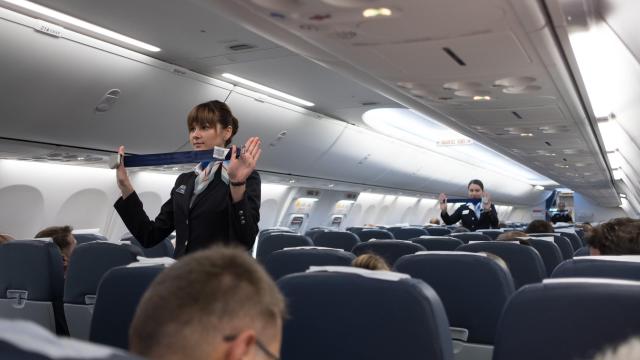Flying commercial is usually a fraught experience, but a reported uptick in in-flight incidents concerning unruly passengers has only compounded the possible annoyance of stepping onboard a plane. If you’re ever to witness one of these ugly scenes — whether it’s two passengers pushing and shoving each other, or someone getting violent with a crew member — you might have the urge to intervene, but should you?
Some people might have the impulse to spring to action, but there are things to know before you ultimately decide to intervene in a confrontation on an aeroplane, whether you’re idling on the tarmac or cruising at altitude.
Should you intervene during a conflict onboard a plane?
Breaking up a fight or a dispute onboard a plane isn’t the same as breaking up some minor conflict between kids at the park. For one, there are serious legal implications involved — like an airline could shoulder liability for an injured passenger, if ruled guilty in court — although passengers are technically allowed to go rogue in an attempt to ensure the safety of themselves and everyone else on the plane.
Conde Nast Traveller details Article 10 of the Tokyo Convention, which has dictated the punishment of crimes committed on aircrafts since 1975:
[I]n a situation where anyone, including a passenger, believes someone near them poses a threat to either the plane or another passenger, they have the right to take “reasonable preventive measures” without asking permission.
That’s a rule governing severe situations, like the possibility of terrorist attacks, however. For our purposes, we’re not discussing issues that might carry an international weight, but rather the kind of regular disputes that routinely boil over between passengers on an otherwise innocuous commercial flight. When it comes to these situations, the first thing to know is that initial responsibility for diffusing tension will fall on the flight crew.
As Garry Leff, an independent airline analyst tells Lifehacker, jumping into the fray might only complicate matters further. “Don’t get involved. It can be difficult to disentangle fault,” he says. “If a crew member requests assistance, that is another matter.”
It’s important to let the crew handle matters initially, especially if you haven’t received express consent from flight attendants to help them subdue a belligerent or violent passenger. This is important, as physically harming a flight attendant can carry a prison sentence of up to 20 years if you’re convicted.
When it comes to the concerned traveller, Leff says to wait for the crew member’s word:
A passenger may need to be restrained and passengers have frequently been able to subdue belligerent, drunk or high and violent individuals. But this should always and everywhere be in support of crew and not something to take on as a solo mission.
In other words, be on alert if you think a flight attendant might need your assistance, but don’t avail yourself as the aeroplane rent-a-cop.
Filming unruly passengers is good, actually
One thing you can do if caught up in the midst of a disorderly and disruptive passenger is film their behaviour. The possibility of public shame, especially if someone is behaving in a contemptible, violent, racist, or otherwise deplorable way, is a good deterrent, Leff says. “Filming is important for customers, because it’s often the only way to prove what really happened and as a defence against what others may say occurred in an incident,” he says.
While certain airlines may threaten legal action against a passenger filming an unflattering event, there isn’t any formal law forbidding you from taking out your phone and hitting record. However, be careful, as traditional First Amendment rights go out the window once an aeroplane takes off and the wheels go up. “Airlines have more power on planes because as private parties they are not bound by the First Amendment,” Associated Press columnist David Koenig wrote in 2017.
Still, their enforcement of these rules are subjective, and as evidenced by the multitude of viral videos showcasing in-flight incidents, it’s safe to say that you’re probably fine when it comes to filming.
“I think filming has largely come to be expected in public so while some may react badly to it, that’s less likely than it used to be,” Leff says.
So when it comes down to intervening, always wait for the crew to make the first call and stand by with your phone if you feel filming the incident will help resolve the situation.

Leave a Reply
You must be logged in to post a comment.